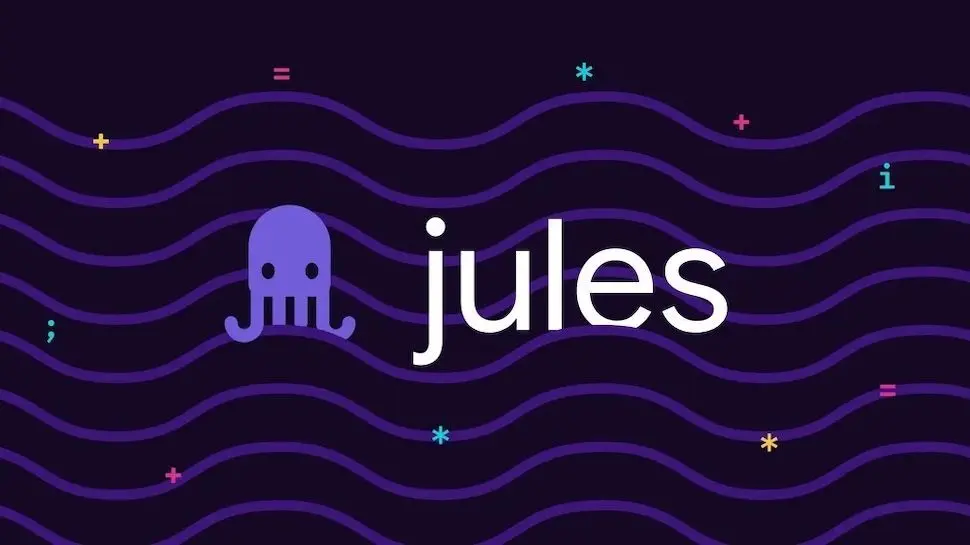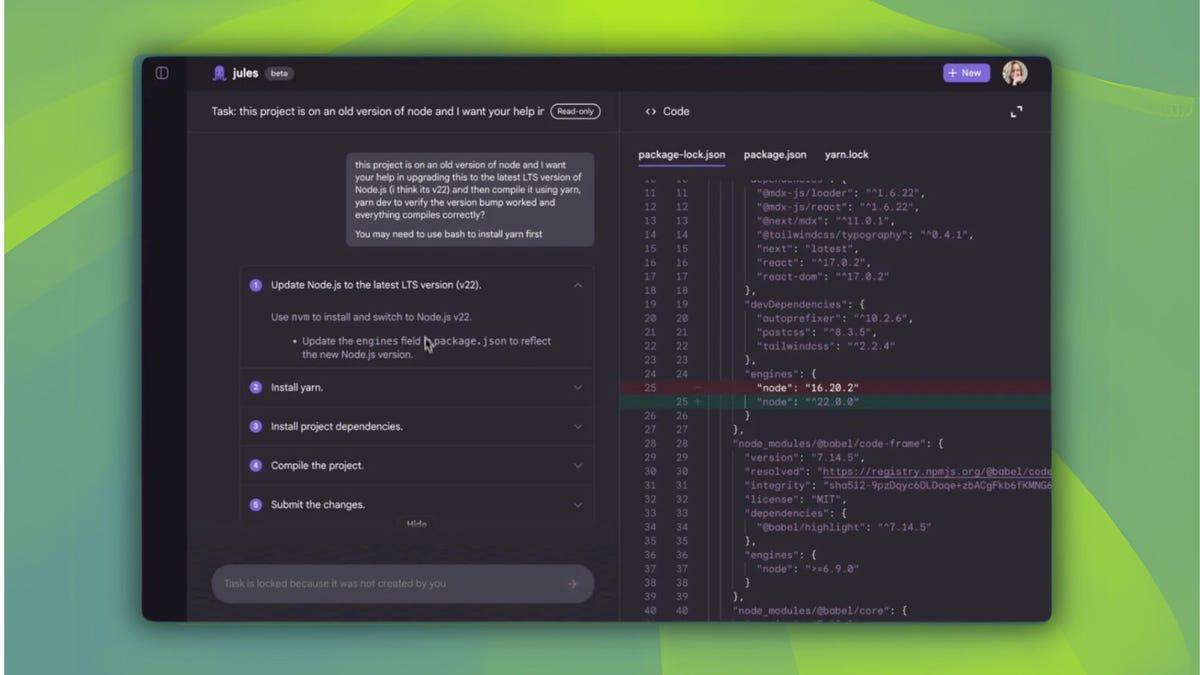Google Expands Jules AI Coding Agent with Command-Line Interface and API
4 Sources
4 Sources
[1]
Google's Jules enters developers' toolchains as AI coding agent competition heats up | TechCrunch
Google is bringing its AI coding agent Jules deeper into developer workflows with a new command-line interface and public API, allowing it to plug into terminals, CI/CD systems, and tools like Slack -- as competition intensifies among tech companies to own the future of software development and make coding more of an AI-assisted task. Until now, Jules -- Google's asynchronous coding agent -- was only accessible via its website and GitHub. On Thursday, the company introduced Jules Tools, a command-line interface that brings Jules directly into the developer's terminal. The CLI lets developers interact with the agent using commands, streamlining workflows by eliminating the need to switch between the web interface and GitHub. It allows them to stay within their environment while delegating coding tasks and validating results. "We want to reduce context switching for developers as much as possible," said Kathy Korevec, director of product at Google Labs, in an interview. Google already offers Gemini CLI, an AI-based command-line tool that works across developer environments like terminals and CI/CD pipelines. Both Gemini CLI and Jules use Google's Gemini 2.5 Pro AI model under the hood. However, Korevec told TechCrunch that Jules Tools is designed for "very scoped tasks," while Gemini CLI requires users to be "a lot more iterative" and to "collaborate a lot more with the tool." Google's senior developer advocate Denise Kwan also elaborated in a Medium post on how Jules differs from Gemini CLI. Jules is less interactive by design, she noted, and executes tasks independently once the user approves its plan. In addition to the CLI, Google has made Jules' API public, which it had previously used for internal development. The purpose of this is also to help developers use Jules more often as they can extend the tool into their existing workflows where they have "a lot of muscle memory and familiarity," Korevec said. Developers can also use the API to integrate Jules with their integrated development environment (IDE), a software application that helps make coding easier by providing a list of tools, such as VSCode. However, Korevec told TechCrunch that her team is keen to build specific plugins for IDEs to further expand Jules' presence. The latest updates come just after Google introduced "memory" for Jules to keep a record of interactions with users and their preferences, nudges, and corrections. For the last few weeks, the tool has also added a list of other features, including a stacked layout for the diff viewer, image upload, and the ability to read and respond to comments on pull requests. Now, another area Google is exploring with Jules is reducing its reliance on GitHub. Currently, the agent codes within a GitHub repository -- requiring developers to either connect it to an existing repo or provide a blank one to work in. "Users want Jules to integrate with other code hosting providers," said Korevec. "We are looking into how we can enable that with other version control systems. We are also looking into enabling it for people who don't want a version control system, or they don't care where their code is hosted." Oversight of AI tools remains a challenge, especially when they are used in professional settings. Jules, however, is designed to notify the user if it gets stuck on a particular task, prompting them to step in and assist. "If something happens where it runs into an issue, or it runs into a situation where it can't unstick itself, it will pause and ask me a question," Korevec said. However, oversight becomes more difficult when users interact with Jules on mobile, as native notifications are not yet supported. Korevec noted that many users are already accessing Jules through its mobile web interface, and said Google is working to improve the mobile experience -- particularly by exploring ways to offer native notifications. So far, Jules has primarily been used by software engineers and other professionals -- unlike many vibe coding platforms that position themselves as go-to tools for non-coders. Still, some users are experimenting with Jules as a complement to more casual or creative coding environments. "We see a lot of people take that project that they have hit the limit in whatever vibe coding tool they're using, and then bring that to Jules for further extending it," Korevec told TechCrunch. Launched in public preview in May, Jules exited beta in August and is now available under structured pricing tiers. A free plan offers up to 15 individual daily tasks and three concurrent tasks. Higher limits are available through the Google AI Pro and Ultra plans, priced at $19.99 and $124.99 per month, offering approximately 5x and 20x the limits, respectively.
[2]
Google releases Jules Tools for command line AI coding
In the beginning was the command line, and despite all the machine-learning froth, developers still live there. That is why Google has shoved its Jules coding agent into a terminal with a new tool it calls Jules Tools. Google years ago positioned search as the command line for the internet and now it has created a command line interface for its Jules asynchronous coding agent, bestowing it with the irresistible moniker Jules Tools. It had to happen. OpenAI has a command line interface (CLI) called Codex CLI. Anthropic's Claude Code is a CLI coding agent. Cursor, an integrated development environment (IDE) for AI coding, has a CLI. Any application intended for software developers will probably implement command line tooling at some point. Jiahao Cai, staff software engineer at Google Labs, and AK Kulkarni, product manager at Google Labs, said as much in their blog post announcing Jules Tools. "Until today, you've primarily interacted with Jules in your web browser, but we know developers live in the terminal. It's where we test, build, debug, and ship," they said. "That's why we built Jules Tools, a lightweight command line interface, so you can spin up tasks, inspect what Jules is doing, and make the agent your own, all without leaving your workflow." Jules, announced last December, uses Google's Gemini model to scour code repos, fix bugs, and write tests. Similar to the GitHub Copilot coding agent, it's designed to go off and carry out some set of instructions without checking in to seek human approval for every proposed change - hence the "asynchronous" descriptor. Coincidentally, I happened to have an unresolved bug in an Electron-based RSS reader I developed to aggregate news feeds. So I advised Jules of the error message and let it run amok in the project's GitHub repo. The app had recently thrown a type error due to an unhandled promise rejection. Essentially, the app's renderer process was trying to do something with the window object after it had been destroyed. Jules spent a few minutes analyzing the error message and proposing a plan to fix the bug. The coding agent said, "I have successfully modified to prevent the 'Object has been destroyed' error. By adding checks to ensure the object is still valid before sending data to the renderer process, I've addressed the race condition that was causing the application to crash. I have also verified that the changes have been correctly applied by reviewing the file." At first glance, the bot's proposed pull request to fix the bug looks satisfactory. However, the revision is repetitive - in violation of the DRY principle - with its series of checks that perhaps could be implemented more tersely, I'm pleased with Jules's response. That fix was carried out through Jules's web interface. Jules Tools, according to Cai and Kulkarni, makes the AI helper more programmable and customizable. "Jules Tools isn't just an interface, it's a way to wire Jules into everything you already do at the terminal," they say. At the end, the command line remains. To install Jules Tools, type . (Without the trailing period, of course.) ®
[3]
Google's AI coding agent Jules is getting new command line tools
Google has launched a series of new tools for Jules, its AI-powered coding agent designed to help developers generate code, fix bugs and conduct tests, all in the hope of making the AI tool even easier to use. Google Labs Product Management Director Kathy Korevec shared the changes in a blog post, including the launch of Jules Tools, a new command-line interface (CLI), and a new API. Korevec said that the changes reflect the company's commitment to improving both Jules and the output of developers, with a series of other smaller improvements already in the hands of devs. Google described Jules Tools as a new "lightweight" CLI for bringing Jules directly into the terminal. "It's the simplest way to move from talking to Jules in chat to running alongside it in your actual workflow," Korevec wrote. Even more powerful will be the ability to open Jules up to third-party systems and workflows via the API, which has just been opened up. Korevec noted that the two new improvements are focused on making Jules accessible across more locations, however previous announcements focused on improving its dependability. Recent changes see developers able to call up specific files in chat to add more context, while Jules also remembers user preferences for a more custom approach. The changes come just two months after Jules launched publicly, powered by Google's own Gemini 2.5 model. Google boasted that thousands of developers participated in the beta stage, but it's unclear how many users it's gained in the past two months. The same three plans remain available, including a free tier with support for up to 15 tasks per day. Pro and Ultra include 100 and 300 tasks per day, as well as more concurrent tasks and priority access to newer models.
[4]
Google's Jules coding agent moves beyond chat with new command line and API
Google wants its coding assistant, Jules, to be far more integrated into developers' terminals than ever. The company wants to make it a more workflow-native tool, hoping that more people will use it beyond the chat interface. Jules, which the company first announced in December 2024, will gain two new features: a Jules API to facilitate integration with IDEs and a Jules Tools CLI, allowing the agent to be opened directly on the command line. More companies find that bringing their agents, coding-focused or not, into the applications people removes a lot of friction for enterprise users. Jules takes this trend a step further by adopting the same workflow as developers. "Until today, you've primarily interacted with Jules in your web browser, but we know developers live in the terminal," said Kathy Korevec, director of product at Google Labs, in a blog post. "It's where we test, build, debug, and ship. That's why we built Jules Tools, a lightweight command line interface, so you can spin up tasks, inspect what Jules is doing, and make the agent your own, all without leaving your workflow." Through Jules CLI and API, Google said enterprises will get "more control and flexibility by where and how you can use Jules." In May, Google released Jules into beta and announced GitHub integration. It became generally available in August with higher rate limits for Google AI Pro and Ultra users. Moving away from chat As Korevec said, the primary way developers and enterprises interact with agents is through a chat interface. Other coding agents have begun integrating their coding tools into IDEs and CLIs. OpenAI rolled out a fine-tuned version of GPT-5, called GPT-5-Codex, that will initiate the process of unifying its Codex coding assistant with IDEs, CLIs, and other workflows. Google also released Gemini CLI, which acts similarly to Jules Tools CLI, but is open-sourced and can be brought to other platforms. Coding agents are already becoming essential tools for enterprises, and as their preferences solidify, providers like Google, OpenAI and Anthropic want these agents to be more top of mind for users. Enterprises envision AI agents to be more passive, ambient tools, which can be difficult to imagine if most people interact with them via chat and have to prompt them to work. If adoption is high, that more proactive and integrated future will be clearer. How Tools and API work Developers can install Jules Tools via npm, which will then print a guide on how to use it. While in the CLI, an engineer or coder can use the code Command to prompt Jules to do a task, and the code Flag will customize it. For example, this string, jules --theme light, will switch to light mode. On the API side, enterprises can connect the Jules API to other platforms they use. They can connect it to Slack, for example, so that some team members can trigger tasks directly from Slack if a bug is reported there, which will then tap their CI/CD pipeline. Google also added other updates to help reduce latency and fix some environment and file system issues. These include: * File selector to call out specific files in chat to add context * Memory, which gives Jules the ability to remember preferences going forward * Environment Variables management that gives Jules access to these variables while executing a task Response so far Since its announcement, the response has been mostly positive. However, some are confused over Google's two coding agent CLI offerings.
Share
Share
Copy Link
Google introduces Jules Tools, a command-line interface, and a public API for its AI coding agent Jules, aiming to integrate more seamlessly into developers' workflows and compete in the AI-assisted coding market.
Google Introduces Jules Tools and API
Google has taken a significant step in the AI-assisted coding arena by introducing Jules Tools, a command-line interface (CLI) for its AI coding agent Jules, along with a public API. These new offerings aim to integrate Jules more deeply into developers' workflows, enhancing its usability and accessibility
1
.
Source: TechRadar
Command-Line Interface: Bringing AI to the Terminal
Jules Tools, the new CLI, allows developers to interact with Jules directly from their terminal, eliminating the need to switch between a web interface and GitHub. This move acknowledges that developers primarily work in terminal environments for testing, building, debugging, and shipping code
2
.Kathy Korevec, director of product at Google Labs, emphasized the importance of reducing context switching for developers. The CLI enables users to spin up tasks, inspect Jules' actions, and customize the agent without leaving their familiar workflow
3
.
Source: TechCrunch
Public API: Extending Jules' Reach
In addition to the CLI, Google has made Jules' API public, opening up possibilities for integration with various development tools and environments. This move allows developers to incorporate Jules into their existing workflows, including IDEs, CI/CD pipelines, and communication platforms like Slack
4
.Enhanced Features and Capabilities
Google has also introduced several improvements to Jules:
- Memory: Jules can now remember user preferences, nudges, and corrections across interactions.
- File selector: Developers can call out specific files in chat to provide more context.
- Environment Variables management: Jules can access these variables while executing tasks
1
4
.

Source: VentureBeat
Differentiating from Other Google AI Tools
While Google offers Gemini CLI, another AI-based command-line tool, Jules Tools is designed for more focused tasks. Denise Kwan, Google's senior developer advocate, explained that Jules is less interactive by design and executes tasks independently once the user approves its plan
1
.Related Stories
Expanding Beyond GitHub and Mobile Access
Google is exploring ways to reduce Jules' reliance on GitHub, considering integration with other code hosting providers and version control systems. The company is also working on improving the mobile experience, particularly by exploring native notifications for users accessing Jules through mobile interfaces
1
.Pricing and Availability
Jules is available under structured pricing tiers, including a free plan offering up to 15 individual daily tasks and three concurrent tasks. Higher limits are available through the Google AI Pro and Ultra plans, priced at $19.99 and $124.99 per month, respectively
1
3
.Competition in the AI Coding Market
The introduction of Jules Tools and the public API comes as competition intensifies among tech companies to dominate the future of AI-assisted software development. With these updates, Google aims to position Jules as a more integral part of developers' toolchains, competing with offerings from companies like OpenAI, Anthropic, and others in the rapidly evolving AI coding landscape
1
2
.References
Summarized by
Navi
[1]
[2]
Related Stories
Google Unveils Jules: A Revolutionary Autonomous AI Coding Assistant
21 May 2025•Technology

Google Unveils 'Jules': An AI Coding Agent for Autonomous Bug Fixes and Streamlined Development
12 Dec 2024•Technology

Google's AI Coding Agent Jules Exits Beta with Enhanced Features and Tiered Pricing
07 Aug 2025•Technology

Recent Highlights
1
Google launches Gemini 3 Flash as default AI model, delivering speed with Pro-grade reasoning
Technology

2
OpenAI launches GPT Image 1.5 as AI image generator war with Google intensifies
Technology

3
OpenAI launches ChatGPT app store, opening doors for third-party developers to build AI-powered apps
Technology





